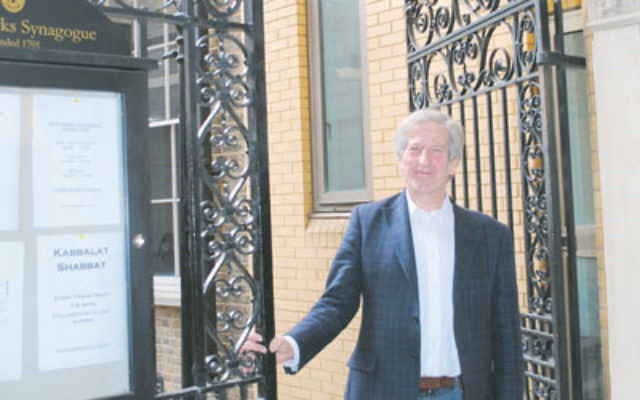Memories of Jewish London
LONDON is best explored on foot and Stephen Burstin’s tour of old Jewish East End, spread over a couple of hours, gives a fascinating insight into the Jewish community that once thrived in the area.
The East End covers a large area and you may need more than one tour to see everything, especially if you want to stop for a kosher lunch at the Bevis Marks restaurant, a short distance from the Bevis Marks synagogue.
Burstin was born in the East End and has an intimate knowledge of the area, which once was home to 95 per cent of the local Jewish community.
His most popular tour starts from Aldgate tube station, near the plaque to the first synagogue after the Resettlement in 1657, when the Sephardi community acquired premises for a new synagogue, which was used until 1701 when the Bevis Marks synagogue opened.
Situated on Camomile Street, where wrought iron gates lead to the courtyard, Bevis Marks is the oldest surviving synagogue in England, straddling the border between the East End and the city’s financial district.
Founded primarily by Dutch Jews whose ancestors fled the Spanish Inquisition, the original interior features a beautiful Renaissance-style ark, brass chandeliers and wooden prayer benches.
The Bevis Marks shul boasts several famous sons including philanthropist Moses Montefiore (1784-1885) and a former British prime minister Benjamin Disraeli (1804-81), whose father turned his back on Judaism and converted the family to Christianity when Benjamin was 12.
Nearby is another shul, the Sandys Row Synagogue, which was founded in 1854 by migrants from Holland and is still functioning as an Ashkenazi prayer house.
In Brune Street is the Soup Kitchen for the Jewish Poor, built in 1902 for Jewish migrants in need of food. In the Depression years it served more than 5000 meals a day and after World War II provided meals on wheels for the elderly. It closed in 1990 and today is home to luxury apartments, but it still retains its ornate facade and original name.
Opposite is the site of the Jews Free School, which opened in 1732. By 1900 it was the biggest elementary school in the area with more than 4000 pupils. Most were migrant children who could only speak Yiddish and in a desperate bid to Anglicise them, only English was permitted inside the school. During World War II the school was moved to other parts of London.
The famous Petticoat Lane street market dates from the 1750s and by the late 19th century 95 per cent of the sellers were Jewish, and they sold predominantly cheap clothes. After World War II the majority of East End Jews moved out to the London suburbs and beyond, making way for another wave of migrants from the Indian sub-continent.
Brick Lane, where the air was once thick with the smell of kosher delicacies such as pickled herring and freshly-baked bagels, now has the aromas of curry and kebabs. All the local street signs are in English and Bengali.
However, Mr Epstein, the sole remaining Jewish trader in Brick Lane, proudly sports his yarmulke outside his fabric shop as he chats with Bangladeshi neighbours.
The mosque in Brick Lane encapsulates the changing nature of the area. It started life as a Protestant church in 1743, became the Spitalfields Great Synagogue in 1898 for the ultra-Orthodox Machzikei Haddas ve Shomrei Shabbat and in the 1970s the building started being used as a mosque.
A house in Princelet Street has a plaque to the birthplace of Miriam Moses, who became Britain’s first Jewish female mayor in 1931.
A little further up the road is the site of the first purpose-built Yiddish theatre that was established in 1886 by Jacob Adler, a Russian Yiddish actor who settled in London. Known as the Hebrew Dramatic Club, it closed in 1887 after 17 people were trampled to death when someone maliciously shouted “Fire!”.
There are other areas of London with a fascinating Jewish history including Golders Green, Stamford Hill, Hampstead and, of course, the Jewish Museum in Camden Town where there are four permanent galleries exploring Jewish heritage plus one for changing exhibitions.
Enquiries: www.jewishlondonwalkingtours.co.uk.
REPORT by Danny Gocs
PHOTO of tour guide Stephen Burstin at the Bevis Marks synagogue in London.
VIDEO: Sights of Jewish London


comments